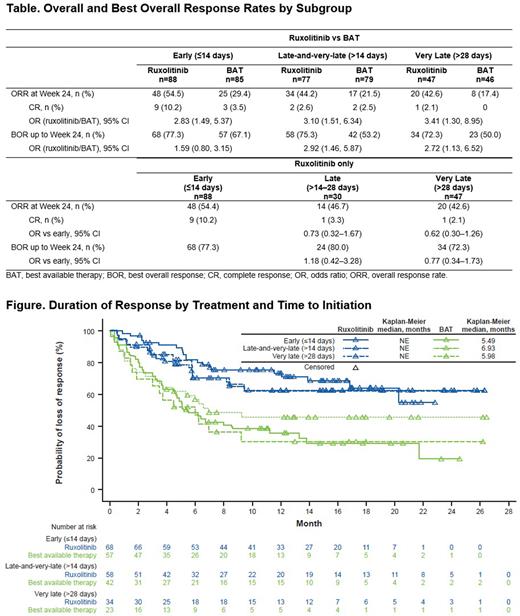Abstract
Background: Chronic graft-versus-host-disease (cGVHD) occurs in a relevant proportion of long-term survivors after allogeneic hematopoietic stem cell transplantation and is a leading cause of morbidity and nonrelapse mortality. Standard first-line treatment for cGVHD is systemic corticosteroids; however, approximately 40%-60% of patients either do not respond or become refractory and require additional systemic therapy. Ruxolitinib is an oral, selective Janus kinase (JAK)1/JAK2 inhibitor approved for steroid-refractory (SR)-cGVHD in adult and pediatric patients aged ≥12 years after failure of ≤2 lines of systemic therapy. In the phase 3 pivotal REACH3 trial, compared with best available therapy (BAT), ruxolitinib significantly improved response rates and allowed for steroid tapering among patients with SR-cGVHD. The impact of timing of ruxolitinib initiation on treatment response and patient outcomes needs further investigation.
Methods: REACH3 (NCT03112603) was a phase 3 randomized, open-label, multicenter study in which SR-cGVHD patients aged ≥12 years with moderate or severe SR or steroid-dependent cGVHD were randomized to receive either ruxolitinib 10 mg twice daily or investigator-selected BAT. This post hoc analysis examined overall response rate (ORR [complete response (CR) + partial response (PR)]) at Week 24, best overall response (BOR) at any time, and duration of response (DOR) between early (≤14 days from SR-cGVHD), late (>14-28 days), very late (>28 days), or late and very late (>14 days) study treatment initiation. Subgroups were defined based on time from SR-cGVHD to randomization. DOR was measured as the time from first documented CR or PR among those with response at Week 24. Odds ratio (OR) and 95% CI for ORR and BOR were calculated using stratified Cochran-Mantel-Haenszel test or Wald confidence limits. DOR was analyzed with the Kaplan-Meier method.
Results: Overall, 165 patients were randomized to ruxolitinib (n=88, 77, 47 for early, late-and-very-late [>14 days], and very late, respectively) and 164 to BAT (n=85, 79, 46). Median age ranged from 47-51 years between subgroups, and most patients were male (range between subgroups, 52.9%-66.2%). Approximately half of patients had experienced prior acute GVHD (range between subgroups, 47.8%-55.8%). Patients had moderate (42.9%) or severe (56.8%) SR-cGVHD at time of study entry; mean time from cGVHD diagnosis to randomization ranged from 154.3-346.0 days between subgroups.
Ruxolitinib was superior to BAT in all time-to-treatment subgroups for ORR (early: OR, 2.83 [95% CI: 1.49, 5.37]; late-and-very-late: OR, 3.10 [95% CI: 1.51, 6.34]; very late: OR, 3.41 [95% CI: 1.30, 8.95]; Table). There was a trend toward higher rate of CR for ruxolitinib treatment vs BAT regardless of treatment delay. DOR represented as probability of loss of response over time is presented in the Figure. Ruxolitinib was superior to BAT for BOR of CR or PR up to Week 24 in late-and-very-late (OR, 2.92 [95% CI: 1.46, 5.87]) and very late subgroups (OR, 2.72 [95% CI: 1.13, 6.52]) and numerically greater in the early treatment subgroup (OR, 1.59 [95% CI: 0.80, 3.15]; Table).
No differences in ORR, BOR (Table), or DOR were observed between ruxolitinib time-to-treatment subgroups.
Conclusions: These data demonstrate that ruxolitinib provides clinical benefit compared with BAT regardless of time elapsing between onset of SR-cGVHD and treatment start. These findings confirm ruxolitinib as an effective treatment option compared with BAT that leads to durable responses in patients with cGVHD.
Disclosures
Zeiser:Incyte Corporation: Honoraria, Speakers Bureau; Mallinckrodt: Honoraria, Speakers Bureau; Novartis Pharmaceuticals: Honoraria, Speakers Bureau. Xue:Incyte Corporation: Current Employment, Current equity holder in publicly-traded company. Bhatt:Incyte Corporation: Current Employment, Current equity holder in publicly-traded company. Galvin:Incyte Corporation: Current Employment, Current equity holder in private company, Current holder of stock options in a privately-held company. Locatelli:Neovii: Speakers Bureau; Amgen: Speakers Bureau; SOBI: Speakers Bureau; BlueBird bio: Speakers Bureau; Novartis: Honoraria, Speakers Bureau; Jazz Pharmaceuticals: Honoraria; Medac: Speakers Bureau; Miltenyi: Speakers Bureau.
Author notes
Asterisk with author names denotes non-ASH members.


This feature is available to Subscribers Only
Sign In or Create an Account Close Modal